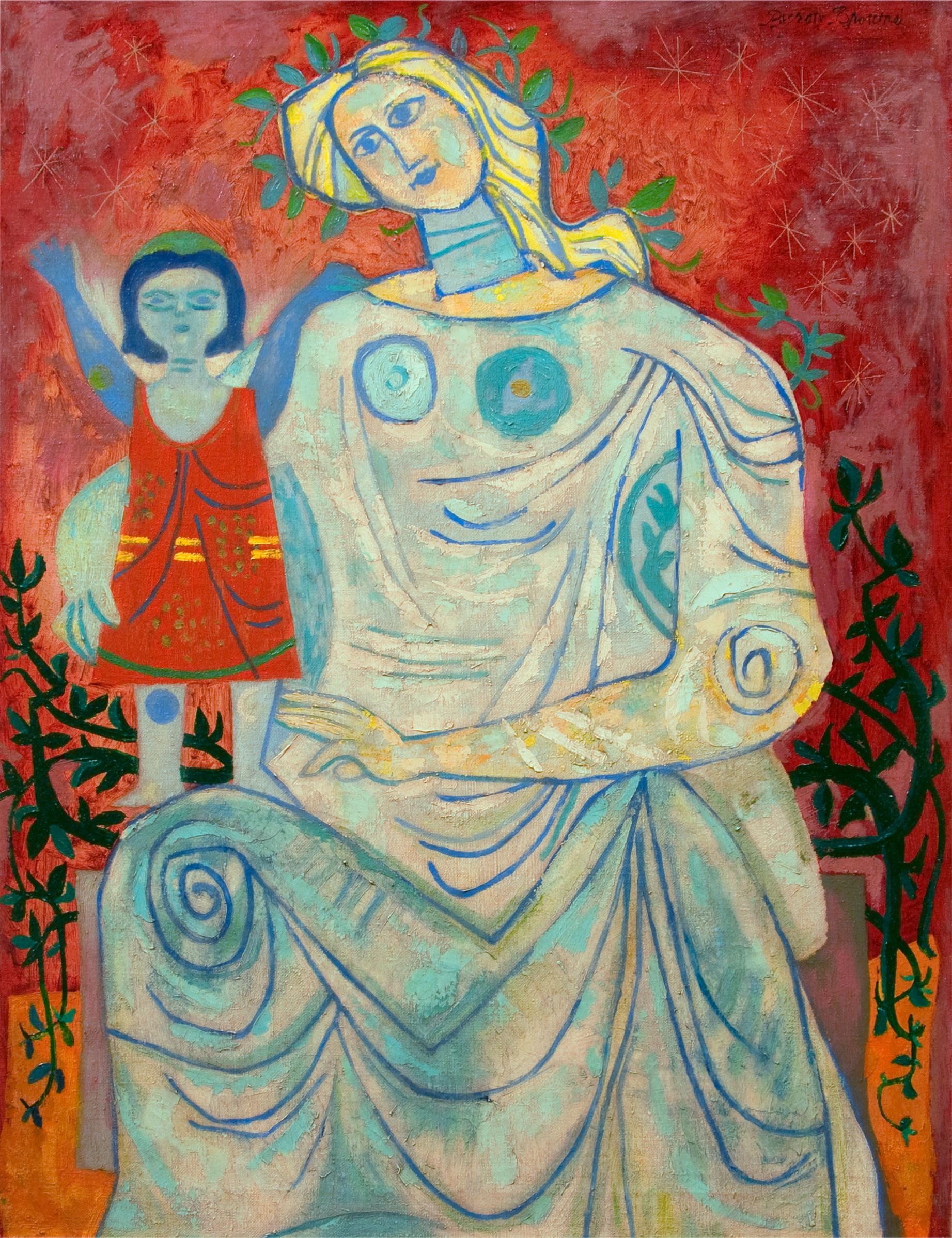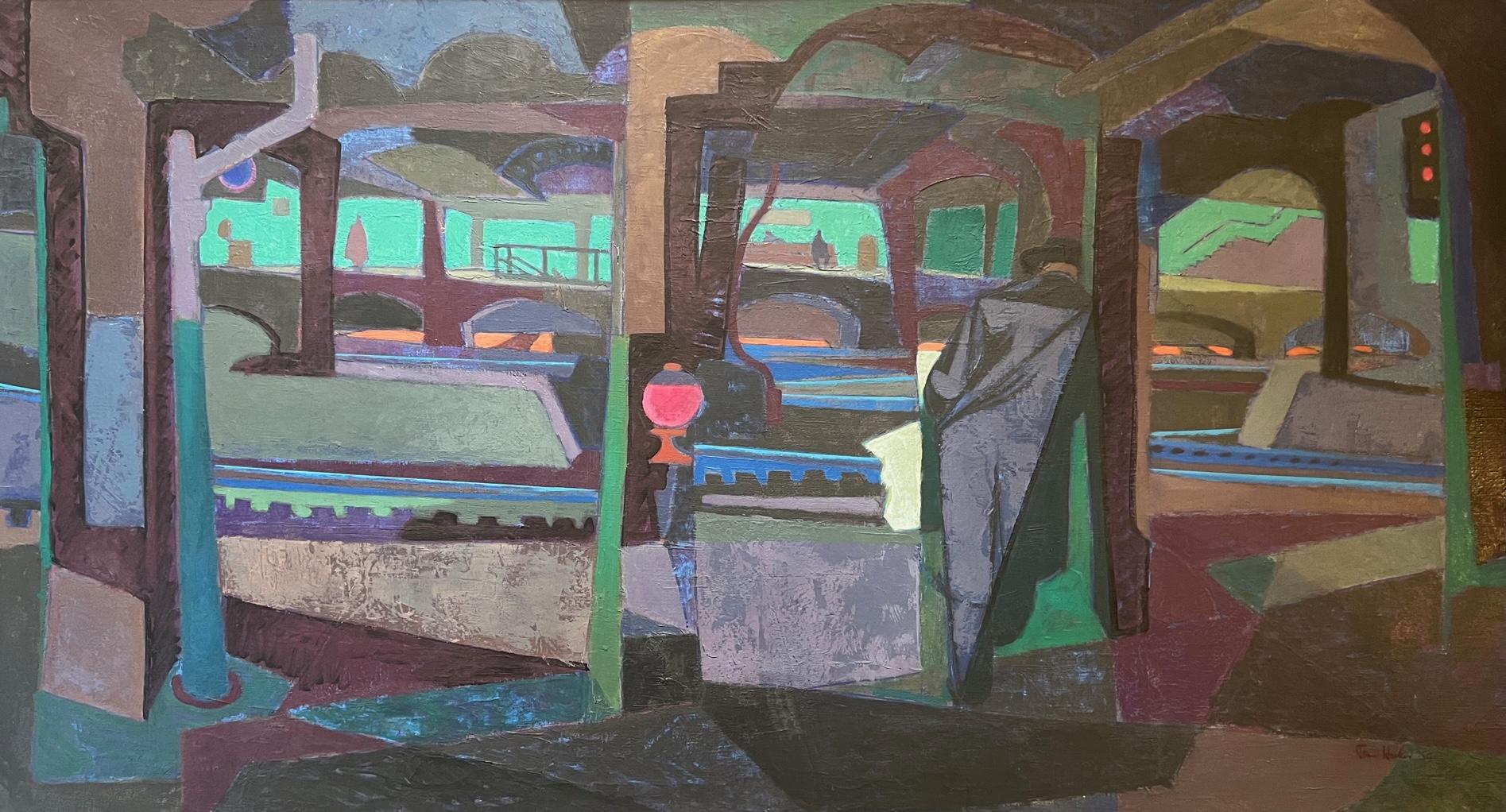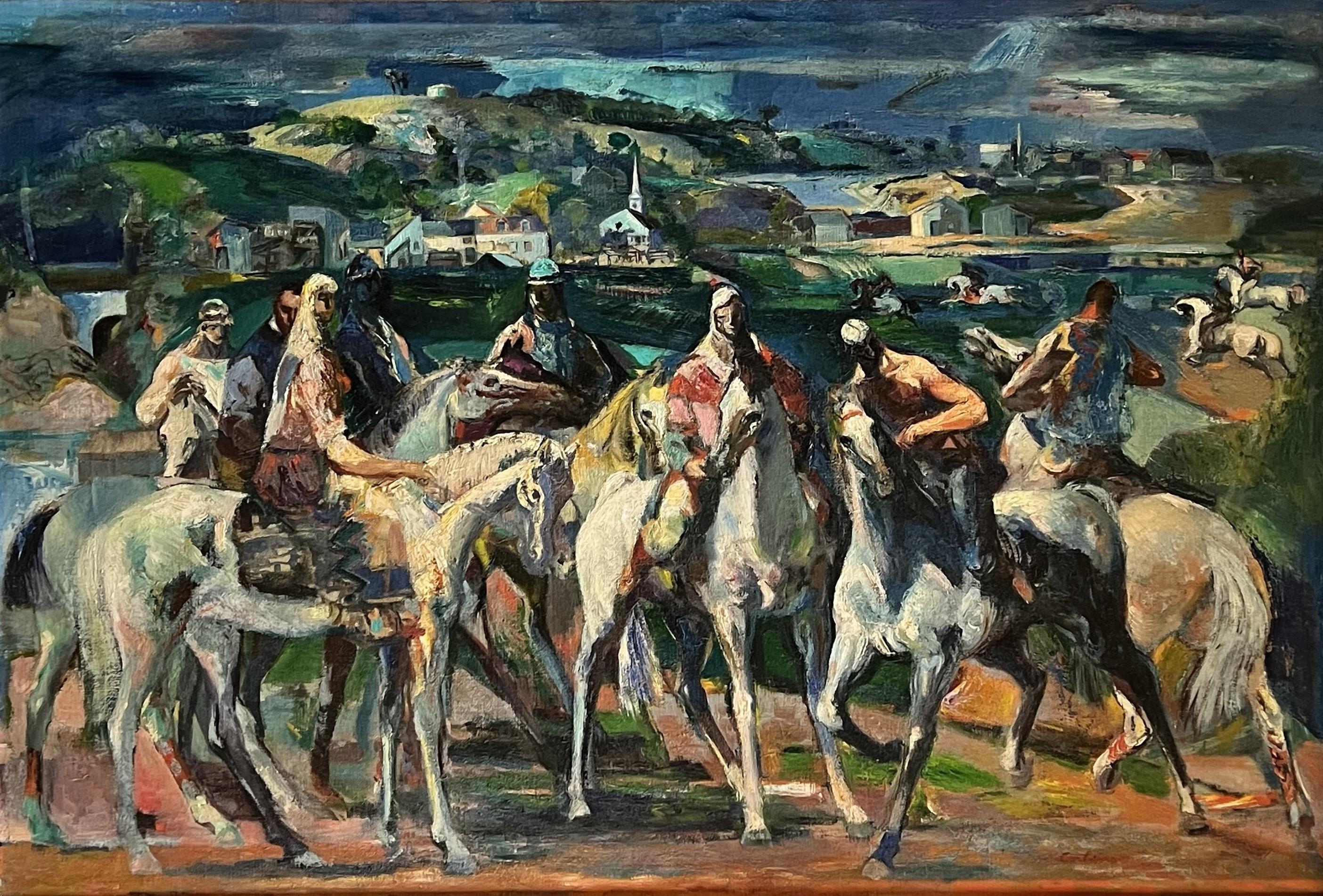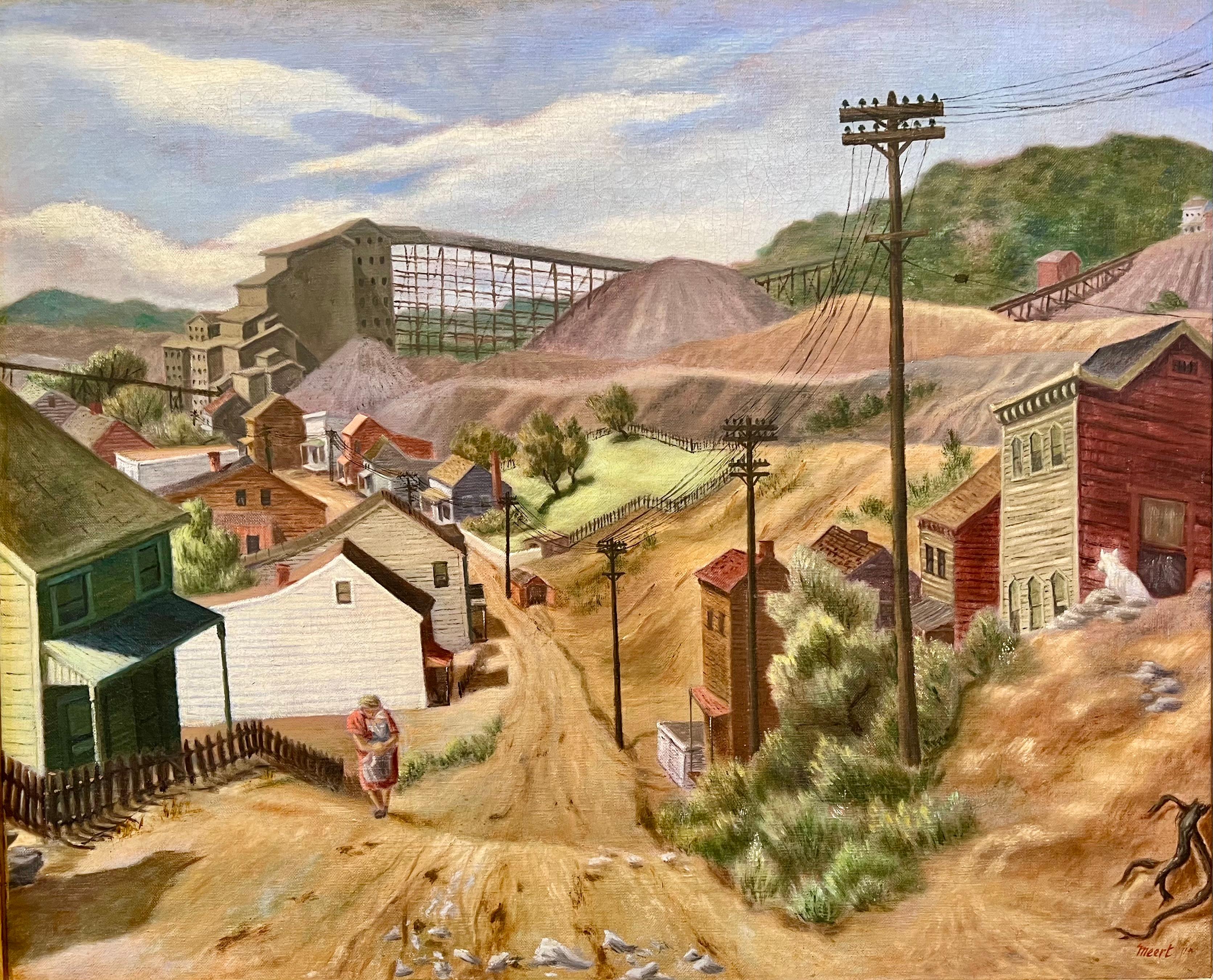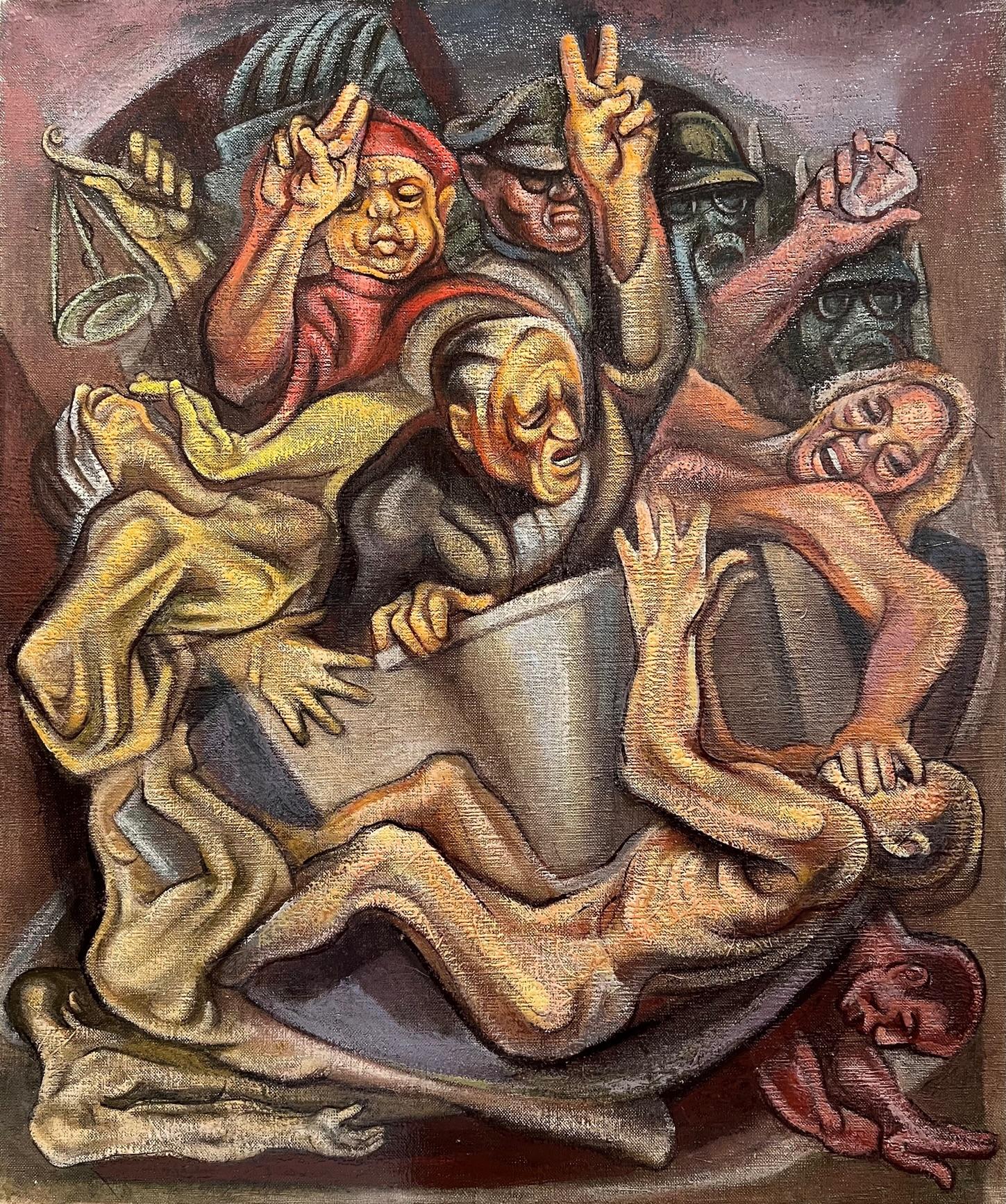Want more images or videos?
Request additional images or videos from the seller
1 of 6
Joseph PolletPortrait
About the Item
Signed lower right.
Description
A portrait of a stylized young man dressed in a blue coat with a ruffled white shirt in an artistic background suggest that it may be a portrait of a young actor or performer.
About the artist.
Joseph Pollet was an important member of the Woodstock Art Colony. He emigrated to NYC in 1911 from Albbruck, Germany (born in 1897) and at age 21 had a promising career as an advertising copywriter. While working, he studied painting and his landscapes were immediately successful in NYC galleries. He studied at the Art Student's League with John Sloan, Robert Henri, and Homer Boss. From 1954-61, he lived in Paris and Italy. In 1971 , a fire destroyed 100-150 paintings of his paintings in his Greenwich Village studio.
Pollet exhibited at the Corcoran Gallery, Chicago Art Institute, Brooklyn Museum, Pennsylvania Academy, Los Angeles County Museum, and Carnegie International.
(Source: Falk, P. Who Was Who in American Art)
- Creator:Joseph Pollet (1897 - 1979, American)
- Dimensions:Height: 24 in (60.96 cm)Width: 21 in (53.34 cm)Depth: 4 in (10.16 cm)
- Medium:
- Movement & Style:
- Period:
- Condition:
- Gallery Location:Saratoga Springs, NY
- Reference Number:1stDibs: LU17028283662
About the Seller
4.2
Vetted Seller
These experienced sellers undergo a comprehensive evaluation by our team of in-house experts.
Established in 1992
1stDibs seller since 2015
30 sales on 1stDibs
Typical response time: 19 hours
- ShippingRetrieving quote...Ships From: Saratoga Springs, NY
- Return PolicyA return for this item may be initiated within 3 days of delivery.
More From This SellerView All
- Parade of ChildrenBy José PalmeiroLocated in Saratoga Springs, NYSigned lower left & dated 1949 verso osé Palmeiro was born in Madrid and followed the tradition of French Impressionism and Post-Cubism. He created an impressive oeuvre comprising of still lifes, landscapes and figural compositions. His artistic career began in 1925 when he went to Paris and met Spanish painters like Ginés Parra...Category
Mid-20th Century Modern Figurative Paintings
MaterialsCanvas, Oil
- Pool HallBy JaimendesLocated in Saratoga Springs, NYSigned lower left.Category
1980s Realist Figurative Paintings
MaterialsCanvas, Oil
- Sand Lot BaseballBy Ralph FasanellaLocated in Saratoga Springs, NYSigned lower right and dated 1954. Bio: FASANELLA, RALPH (1914-97) was a self-taught painter who created large, colorful and intricate paintings of working-class culture and American politics from 1945 until his death in 1997. Fasanella had an artistic vision born of a working life. A child of Italian immigrants, he spent his youth delivering ice with his father and enduring the harsh regimen of a Catholic reform school. During the Great Depression, Fasanella worked in garment factories and as a truck driver. From his mother—a literate, sensitive, and progressive woman, Fasanella acquired a social conscience. Through her influence he became active in antifascist and trade union causes. Fasanella's political beliefs were radicalized by the Depression. His antifascist zeal led him to volunteer for duty in the International Brigades fighting fascism in Spain, where he served in 1937-1938. Upon his return to New York City Fasanella became an organizer for various unions, particularly the United Electrical, Radio, and Machine Workers of America, with whom he achieved some major organizing successes. In 1945, disillusioned by the labor movement and plagued by a painful sensation in his fingers, Fasanella started to draw. He left organizing and began to paint full time. He painted obsessively, capturing the vibrant moods of the city and the tumult of American politics. For a brief time he received some critical notice for his work, and had shows of his work in galleries as well as union halls. Fasanella included in his paintings a profusion of brightly colored details, showed interiors and exteriors simultaneously, and combined past and future. He populated his paintings with likenesses of family and friends. In 1950 Fasanella married Eva Lazorek, a schoolteacher who supported the couple through over two decades of artistic obscurity and blacklisting by the FBI. In the 1950s Fasanella retreated from political content in his works out of fear of reprisals. With the emergence of the New Left in the 1960s, however, his works became large, sharply focused political essays using images from the popular media. In 1972 Fasanella was featured in "New York" magazine and in an illustrated coffee-table book, "Fasanella's City". His large-scale, intricate paintings of urban life and American politics were then introduced to art critics and the public. In the late 1970s Fasanella spent two years in Lawrence, researching the 1912 Bread and...Category
1950s Other Art Style Figurative Paintings
MaterialsCanvas, Oil
- Pont NeufBy François GallLocated in Saratoga Springs, NYSigned and titled lower left. Francois Gall, Hungarian by birth, became a naturalized French citizen in 1942. He is best known as an impressionist painter in the pure French traditi...Category
Mid-20th Century Post-Impressionist Figurative Paintings
MaterialsOil, Canvas
- Paris Street SceneBy Francois GeromeLocated in Saratoga Springs, NYSigned and titled lower left. Francois Gerome was a French painter born in Paris in 1895. He is most well-known for his paintings of women depicted at picturesque spots throughout P...Category
20th Century Impressionist Figurative Paintings
MaterialsCanvas, Oil
- Three Young Street MusiciansBy Juan De PreyLocated in Saratoga Springs, NYSigned lower left. Juan De’Prey was active/lived in New York / Puerto Rico. Juan De’Prey is known for child portrait, genre, harbor view and plantation landscape painting. A self...Category
20th Century Impressionist Figurative Paintings
MaterialsCanvas, Oil
You May Also Like
- Mother and Child -- 1949By Byron BrowneLocated in Washington, DCBryon Browne was an important American modernist painter. Signed upper right; signed, dated and situated 'New York' on reverseCategory
1940s American Modern Figurative Paintings
MaterialsCanvas, Oil
- Six O'ClockLocated in Los Angeles, CASix O-Clock, c. 1942, oil on canvas, 30 x 20 inches, signed and titled several times verso of frame and stretcher (perhaps by another hand), marked “Rehn” several times on frame (for the Frank K. M. Rehn Galleries in New York City, who represented Craig at the time); Exhibited: 1) 18th Biennial Exhibition of Contemporary American Oil Paintings from March 21 to May 2, 1943 at The Corcoran Gallery of Art in Washington, D.C. #87, original price $450 (per catalog) (exhibition label verso), 2) Craig’s one-man show at the Frank K. M. Rehn Galleries, New York City, from October 26 to November 14, 1942, #10 (original price listed as $350); and 3) Exhibition of thirty paintings sponsored by the Harrisburg Art Association at the State Museum of Pennsylvania in Harrisburg in March, 1944 (concerning this exhibit, Penelope Redd of The Evening News (Harrisburg, Pennsylvania) wrote: “Other paintings that have overtones of superrealism inherent in the subjects include Tom Craig’s California nocturne, ‘Six O’Clock,’ two figures moving through the twilight . . . .” March 6, 1944, p. 13); another label verso from The Museum of Art of Toledo (Ohio): original frame: Provenance includes George Stern Gallery, Los Angeles, CA About the Painting Long before Chris Burden’s iconic installation outside of the Los Angeles County Museum of Art, Urban Light, another artist, Tom Craig, made Southern California streetlights the subject of one of his early 1940s paintings. Consisting of dozens of recycled streetlights from the 1920s and 1930s forming a classical colonnade at the museum’s entrance, Burden’s Urban Light has become a symbol of Los Angeles. For Burden, the streetlights represent what constitutes an advanced society, something “safe after dark and beautiful to behold.” It seems that Craig is playing on the same theme in Six O-Clock. Although we see two hunched figures trudging along the sidewalk at the end of a long day, the real stars of this painting are the streetlights which brighten the twilight and silhouette another iconic symbol of Los Angeles, the palm trees in the distance. Mountains in the background and the distant view of a suburban neighborhood join the streetlights and palm trees as classic subject matter for a California Scene painting, but Craig gives us a twist by depicting the scene not as a sun-drenched natural expanse. Rather, Craig uses thin layers of oil paint, mimicking the watercolor technique for which he is most famous, to show us the twinkling beauty of manmade light and the safety it affords. Although Southern California is a land of natural wonders, the interventions of humanity are already everywhere in Los Angeles and as one critic noted, the resulting painting has an air of “superrealism.” About the Artist Thomas Theodore Craig was a well-known fixture in the Southern California art scene. He was born in Upland California. Craig graduated with a degree in botany from Pomona College and studied painting at Pamona and the Chouinard Art School with Stanton MacDonald-Wright and Barse Miller among others. He became close friends with fellow artist Milford Zornes...Category
1940s American Modern Landscape Paintings
MaterialsCanvas, Oil
- Untitled (Elevated Platform)Located in Los Angeles, CAThis painting is part of our current exhibition - America Coast to Coast: Artists of the 1940s Untitled (Elevated Platform), 1950, oil on canvas, signed and dated lower right, 30 x...Category
1950s American Modern Paintings
MaterialsCanvas, Oil
- Riders of Pigeon HillBy Jon CorbinoLocated in Los Angeles, CARiders of Pigeon Hill, c. 1940s, oil on canvas, signed lower right, 24 x 36 inches, label verso with title, artist’s name and address; same information inscribed verso; ex-collection...Category
1940s American Modern Paintings
MaterialsCanvas, Oil
- Gold Mine, Central City, ColoradoBy Joseph MeertLocated in Los Angeles, CAThis painting is part of our exhibition America Coast to Coast: Artists of the 1930s Goldmine, Central City, Colorado, oil on canvas, 36 x 28 inches, c. 1936, signed lower right, ex collection of Platt Fine Art, Chicago, Illinois (label verso). About the Painting Joseph Meert’s painting, Goldmine, Central City, Colorado, depicts the short-lived resurrection of a once prominent city just outside Denver. Central City was founded in 1859 soon after John Gregory struck gold in the area. As word spread, thousands of miners converged into “Gregory’s Gulch” and its surroundings became known as the “richest square mile on earth.” Mining production quickly increased resulting in Central City to becoming Colorado’s largest city in the early 1860s. Despite some technical difficulties transitioning to lode mining and the rise of competition from Leadville, Central City remained an economic boom town through the turn of the century. But, with every boom, there is a bust. World War I marked the end of Central City’s prominence as ore production ground to a halt and by 1925, the town’s population shrank to only 400 people. The desperation of the Great Depression and a nearly 100% increase in the price of gold lured labor and capital back to Central City. Meert painted in Colorado during the mid-1930s, a time when he created his most desirable works. It is during this period of renaissance that Meert captures one of Central City's outlying dirt streets bordered by 19th century wooden houses from the town's heyday and the more recently installed electric lines leading to a distant gold mine. A lone figure trudges up the hill, a mother with a baby in her arms, putting us in mind of the rebirth of the town itself. Meert had solo exhibitions at the Colorado Springs Fine Arts Center in 1936 and the Denver Art Museum. Although it is not known whether Goldmine, Central City was included in either of these exhibitions, it seems likely. Moreover, the painting is closely related to Meert’s painting, The Old Road, which was painted in 1936 and exhibited at the Corcoran Gallery of Art in Washington, DC and at the Dallas Museum of Art. About the Artist Joseph Meert was a well-regarded painter and muralist, who initially made a name for himself in the American Scene and later as an abstract expressionist. Although initially successful, Meert struggled financially and with mental illness later in life. He was born in Brussels, Belgium, but moved with his family to Kansas City, Missouri. As a child, a chance encounter at the Union Pacific Railyard changed his life. Meert happened upon a worker repainting and stenciling a design on a railroad car. Meert later recalled that this experience introduced him to the idea of being a painter. Without support from his father, Meert obtained a working scholarship to the Kansas City Art Institute. After four years at the Kansas City Art Institute, Meert studied seven years at the Art Students League and in Europe and Los Angeles. At the Art Students League, Meert fell under the spell of Thomas Hart Benton and Stanton MacDonald-Wright. In 1931, he befriended Jackson Pollock. By 1934, Meert was part of the Public Works of Art Project when he met his wife, Margaret Mullin...Category
1930s American Modern Landscape Paintings
MaterialsCanvas, Oil
- The DemogogueLocated in Los Angeles, CAThe Demagogue or Tale in a Tub, 1952, oil on canvas, 20 x 24 inches, signed, titled, and dated verso About the Painting The Demagogue is an iconic Bendor Mark painting from the prime of his post-war period. Beginning early in his career, Mark was fascinated with depictions of the human figure and their capacity to tell stories of the world around him. Mark was a keen observer of his times and in The Demagogue we see Mark’s portrayal of a faithless politician holding up a “V” for victory sign as he appeals to the wanton desires and prejudices of the masses. Below the demagogue is a swirl of humanity representing the common man who is being pushed down by the powerful, while the robed figure of liberty with her scales of justice held high is brushed aside. Behind the demagogue, Mark places two other powerful supporting institutions which were often co-opted by the world’s dictators, the Church and the Military. Mark was an internationalist, so it is difficult to know exactly which demagogue inspired him to create this work, but in 1952 there were many to choose from. Whether depicting Argentina’s Peron (the demagogue and the women to the right resemble Juan and Eva Peron), Spain’s Franco or the United States’ homegrown fear mongers like Joseph McCarthy, Mark tells a universal story that unfolded in dramatic fashion during the post-war period as nations and their peoples grappled with authoritarianism and anti-democratic impulses. Stylistically, The Demagogue draws on the elements which make Mark’s work from this period immediately recognizable, a saturated palette, a closely packed and frenetic composition, exaggerated figuration and stylized facial features. But, above all, we see Mark’s ability to tell the stories of the rich and powerful and their ability to oppress. Like Mark’s work in the collection of the Whitney Museum of American Art (The Hourglass - 1950-51) and the Los Angeles County Museum of Art (Execution – 1940), The Demagogue pulls no punches, as the artist lays bare the threats to freedom and basic human rights. About the Artist Bendor Mark was an American modernist and social realist painter. Born as Bernard Marcus on June 5, 1912, in Brooklyn, New York, Mark trained at The Cooper Union during the 1920s where he studied with William Brantley van Ingen and became a prize-winning artist with a focus on painting the human figure. After his time at Cooper, Mark continued to live in New York and worked as a commercial artist and textile designer in addition to his pursuit of a career in painting. Like many Depression Era artists, Mark engaged with social progressives and in 1934, he joined the Artist’s Union which had the goal of advancing artists’ position as “worker.” Mark’s painting, Restaurant, which is now in the permanent collection of the Smithsonian American Art Museum, appeared in the February 1936 edition of the Union’s publication, Art Front, as part of a review of an exhibition at ACA Gallery in New York. Mark worked on the Federal Art Project and by the mid- to late-1930s, began a series of paintings exploring the working conditions and hazards of the mining industry. Mark believed that miners were “in the forefront of the struggle for emancipation” and that the mere “struggle for existence is like moving mountains.” He became passionate about the Spanish Civil War and painted sympathetic images in support of the Spanish Republic. Mark was a premature anti-fascist and throughout his career painted works critical of dictators and other oppressors. During the late 1930s, Mark entered mural competitions with designs influenced by the Mexican muralists, taught adult art education in Queens, New York, and was an instructor at the WPA’s Queensboro Art Center. He was so committed to socially progressive art that by 1934, he had changed his name to Bendor Mark, in part, to distinguish his social realist paintings from his earlier work. During World War II, Mark worked as an artist for military contractors. After the war, he was employed as a graphic artist and in the printing industry before moving to Southern California in 1948, where he returned to a fine art practice the following year with politically and socially charged images which reflected his view of the shortcomings of the post-War period, the continued threat of fascism, and the international tensions of the Cold War. As the mood of the country shifted towards the right during the McCarthy Era and the art world’s attention focused on abstraction at the expense of figuration, Mark’s career as a painter suffered. From the 1950s through the 1980s, Mark continued to depict the events that shaped the world around him, often employing a highly stylized approach characterized by dynamic multi-figure compositions, a subtle muted palette, and exaggerated expressive features. A review of Mark’s oeuvre suggests that few people escaped Mark’s attention. He painted presidents, prime ministers, royalty, evangelists, musicians, and dictators (and their henchman), along with miners, farm workers, the urban poor, protesters, the unemployed and dispossessed. He laid bare the arrogance, cruelty, and hypocrisy of the world’s elites. Mark noted, “A work of art cannot be fully appreciated or wholly understood without considering the socio-political and cultural ambience that gave it birth.” He continued, “I have the ability to foresee the direction of social and political events while they are actually taking place.” He was not himself a direct political activist, however. Although Mark commented, “It’s a misconception to separate art from the social aspect of life,” he viewed artists as being neutral. According to Mark, “An apolitical attitude reflects the fact that the artist is passive. . . An artist never affects society; he merely reflects it.” In addition to the Mexican Muralists, Mark was influenced by the old masters Rembrandt, Michelangelo, and Masaccio, as well as the more modern master, Van Gogh. Mark’s writings directly acknowledge these influences and archival material from his estate includes magazine articles, pamphlets and transparencies related to these artists. Mark also collected materials related to several of his social realist contemporaries, including Reginald Marsh, Ben Shahn, Leonard Baskin, and Raphael Soyer, who was Mark’s good friend. For years, Soyer sent Mark holiday cards and Soyer inscribed a message of friendship on a self-portrait he gifted to Mark in the 1970s, all of which are still held in the collection of Mark’s family. From the late 1920s through the mid-1950s, Mark’s work was well received. His paintings won prizes and were accepted into major juried exhibitions including at the Brooklyn Museum, the New York World’s Fair and the Metropolitan Museum of Art. He gained national recognition for paintings depicting the oppressed and the common worker. Despite the decline in popularity of representational art during the 1950s and 1960s, Mark stayed true to his interest in depicting the human figure and by the last two decades of his life, his work underwent a reassessment as curators included Mark’s paintings in exhibitions showcasing the role of labor in art during the Depression Era. This recognition continued in recent years when Mark was honored by having his work included in the Whitney Museum of American Art’s ground-breaking exhibition, Vida Americana, which explored the pioneering role that the Mexican muralists played in the development of modern American art during the inter-war period. The influence of Rivera, Siqueiros and Orozco on Mark is unmistakable and his paintings from the 1950s (and beyond) sit comfortably in dialogue with other Los Angeles artists who continued to paint in the social realist tradition long after the mainstream art world had moved toward abstraction. Mark’s concern for underserved Brown and Black communities was shared with artists such as Charles White and his ally, Edward Biberman...Category
Mid-20th Century American Modern Figurative Paintings
MaterialsCanvas, Oil
Recently Viewed
View AllMore Ways To Browse
Vintage Man Dress
Greenwich Village Vintage
Chicago Fire
Vintage America Shirts
John Sloan Artist
Boss Vintage
1971 Dresses
Gallery Vintage Coat
Chicago Vintage Dresses
Vintage Dresses Chicago
American Portrait Blue Dress
Vintage Dress Los Angeles
Vintage Dresses Los Angeles
Los Angeles Vintage Dresses
Vintage Dress Nyc
Vintage Dresses Nyc
Nyc Vintage Dresses
Vintage Fire Coat
